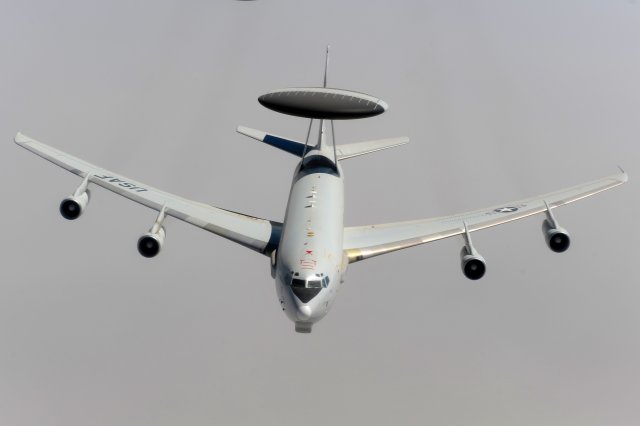| a | |||
| |
|||
World
Aviation Defense & Security News - NATO & USAF |
|||
| NATO and US Air Force launch DRAGON program to upgrade their E-3 Sentry | |||
The
US Air Force and NATO are undergoing a cooperative development effort,
known as the DRAGON program, to upgrade the cockpits of their E-3 Sentry
(AWACS) aircraft. DRAGON, which stands for Diminishing Manufacturing Sources
Replacement of Avionics for Global Operations and Navigation, is finding
that aging AWACS fleets are a main concern for the Air Force and NATO. |
|||
 USAF Boeing E-3 Sentry Airborne Early Warning and Control Aircraft |
|||
"As original equipment manufacturers discontinue support to 40-year-old avionics, replacement parts are becoming harder and harder to come by," said Jennifer Pomphrett, the DRAGON project manager. Easily identified by its 30-foot rotating radar dome, the E-3s use computers and radar to provide detailed aerial pictures of airspace. The DRAGON program office, located at Hanscom Air Force Base, Massachusetts, is the driving force behind the replacement of non-sustainable, mainly analog, equipment. Existing technology will be updated with commercially available, digital avionics systems. The flight deck modernization will include replacing most analog indicators with modern digital multicolor graphic displays. In addition, nearly all of the 1970's avionics are being replaced with updated airspace-compliant subsystems. The modernization will also allow for elimination of the navigator, dropping the crew size from four to three, as well as adding a Mode-5 Identification Friend or Foe capability. All aircraft infrastructure such as engines, airframe and mission systems will remain the same, but the upgraded E-3 flight deck will host a plethora of new technology currently used by the commercial airline industry. Digital satellite-based communications; modern flight management system suite architecture; and a digital cockpit that includes five glass display screens will offer aircrews easy-to-use and customizable engine, navigation and situational awareness data. Other new capabilities will include a weather radar that can predict wind shear; an enhanced ground proximity warning system; warnings, cautions and advisories via an engine instrument and crew alert system; and a fully digital flight deck audio distribution system. In addition to hard-to-find replacement parts, another reason for the AWACS upgrade is due to changing national and international regulations for civil airspace. The International Civil Aviation Organization has imposed new flight mandates that need to be met by 2018. With the flight deck modernization, both U.S. and NATO fleets will meet the mandates and will have broader access to airspace. "Unrestricted flight through preferred airspace takes the E-3 to the fight when it needs to be there," said Sid Kimhan, the DRAGON program manager. “The shorter flying times provided by access to preferred routes reduces costly wear and tear on the fleet and fuel consumption." The Air Force and NATO are progressing together through risk reduction and engineering, manufacturing and development phases, but the organizations will have separate contracts for the production, deployment and operational stages. "This cooperative effort is important because it leverages the 95 percent design commonality between the U.S. and NATO AWACS and promotes interoperability, interchangeability, cost sharing and a common sustainment and logistics pipeline," said Rob Stewart, the DRAGON logistics manager. Boeing, which holds the current engineering, manufacturing and development contract, installed one digital flight deck and avionics system onto the first NATO aircraft, N-1, and will also install another system into an Air Force test aircraft, D-1, in the coming months. Ground testing for the NATO AWACS is slated for September 2014 with an anticipated first test flight scheduled for November. The Air Force expects their 24 updated E-3s to be delivered by the fourth quarter of fiscal year 2025. "We're very pleased with the progress that's being made," said Lt. Col. Brian Clifford, the E-3 operational capabilities branch chief. "This modernization will bring a whole new level of communication, navigation and surveillance to the U.S. and NATO E-3 operational community." |
|||
NATO and US Air Force launch DRAGON program to upgrade their E-3s Sentry
- Posted On
















